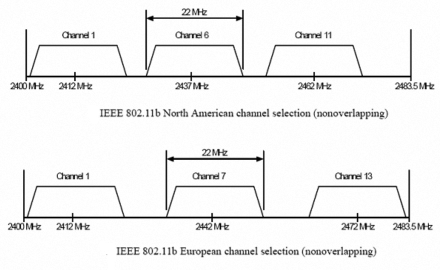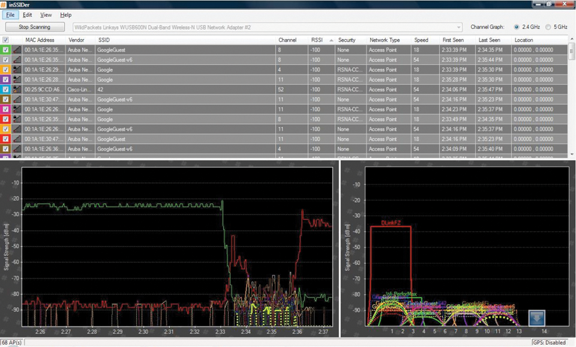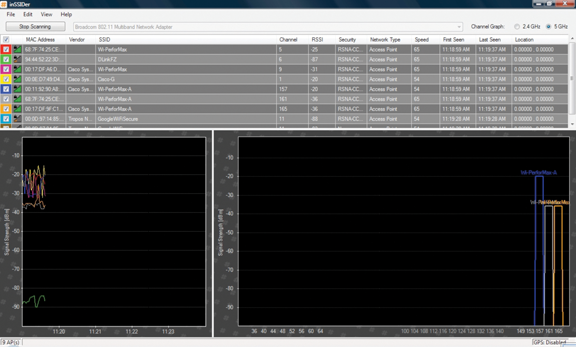Here are the most likely reasons why, along with the forgotten available 5 GHz band.
Wireless networks offer the convenience of not worrying about being tied to various cables, switches, etc., but they also need to be understood according to their limitations.
The growing demand for using the wireless networks in applications that require high bandwidth points to the need for limiting the demand and checking for performance of the individual devices that form the wireless network.
In simple configurations, an Access Point (AP) is used to connect a number of wireless clients that provide the connectivity between the host computers on which these clients operate and the AP. This is independent of connectivity to the internet, i.e. the number of host computers can communicate together via the wireless clients through the AP independent of the internet. The next step up is to connect to the internet if the AP is fed with a live signal to its WAN port and the clients use the AP IP address as the gateway.
Factors to consider:
- Number of channels and number of APs on each channel
- The forgotten 5 GHz A band
- Number of clients on each channel
- Number of clients the AP can handle
- Signal strengths
- Configuration parameters
- Chipset
Number of Channels and Number of APs on Each Channel
The end user is mostly familiar with the band of the operational wireless network. The 802.11 b/g wireless devices operate on 11 channels in North America and on 13 channels in Europe. This is shown in Figure 1. With this limitation, if a corporate wireless network operates in this band with many APs and client cards (for instance 50 APs and 300 clients), the network layout will look like the one shown in Figure 2. That shows an actual scan of the 2.4 GHz band at a Google working facility in Silicon Valley. A close look on the graphs of Figure 2 shows that on every channel (1-11) there are many APs. A possible scenario will be as follows. When a group of users experience difficulty in having smooth connectivity on the wireless network, a new AP is added to resolve the issue. With the limited number of channels and the increasing number of clients, the number of APs per channel will increase. This simply results in performance degradation. One way of enhancing performance in this case will be non-intuitive; that is to reduce the number of APs per channel and redistribute the clients that connect to each AP according to site survey measurements [1].


The Forgotten 5 GHz A Band
At the same time the network scan shown in Figure 2 was taken on the 2.4 GHz band, the 5 GHz band scan was also conducted and shown in Figure 3. In North America the channels of this 802.11A band can be designated as 36, 40, 44, 48, 52, etc. all the way up to 164. Clearly the number of channels on this band is significantly higher than the 11 channels of the 2.4 GHz band. But the utilization of this 5 GHz band is not noticeable. This can be explained by one of two possible scenarios. First the network setup takes into account the radar detection scheme that mandates APs to switch from the current operational channel should a radar signal be detected on the channel. This results in forcing the connected clients to switch to the new channel that its AP will choose to switch to after going through an exchange of bidirectional messages according to the wireless protocol. The second is that the network is just setup on the more popular 2.4 GHz which in many cases is the default of the “out of box” configurations of the wireless devices without paying attention to two main important things. One is that most of these wireless devices have the dual band capabilities i.e. they are capable of operating on either 2.4 or 5 GHz and two is that the 5 GHz is widely open and unpopular. So by overlooking the availability of the huge number of channels of this 5 GHz band, a much cleaner (less noisy) spectrum is totally unutilized where it is handily available.
Figures 4 and 5 show two scans of the 2.4 GHz and 5 GHz in a residential area where the first band is also heavily used while the second is not used at all!

Figure 3: Usage of the 5 GHz band in a typical work environment

Figure 4: Usage of the 2.4 GHz band in a residential area

Figure 5: Usage of the 5 GHz band in a residential area
Number of Clients on Each Channel
- Many clients can be on the same channel with many possible scenarios:
- Many joining the same AP with the same SSID in infrastructure mode.
- Many others join different APs on the same channel, each with different SSID in infrastructure mode.
- Many clients joining a client that created an Ad-Hoc mode.
The occurrence of all these possibilities creates enough busy spectrum to affect the wireless network responsiveness.
Signal Strengths
A direct impact on the wireless network responsiveness is the signal strength that indicates that distance between the communicating nodes. While the absolute value of RSSI is not a reliable indicator (as different devices use inconsistent methods of measuring RSSI), it is an important factor to observe for the same pair of an AP and a client. This points to the need of placing the wireless nodes within close proximity.
Configuration Parameters
Without digging deeply into the effect of configuration parameters of an AP, the wireless network user may need to observe some of the most intuitive parameters and adjust them to achieve better performing network. Some of these are:
- Channel number; a selection of a less busy channel enhances network performance.
- Fragmentation value; OFF value (mostly 2346) will help
- Power Save; OFF on power-line powered devices will also help as there will be no need to conserve energy on devices that do not use batteries.
- DTIM; an influential parameter that the user may try a few values for (mostly 1, 2, or 3) to gain better responsiveness.
Chipset
While the brand name of the wireless device (AP or client) may be an indicator of good behavior based on past experience of using the brand, it should be noted that the same name or model number may utilize different chipsets by different manufacturers. Two different chipsets from two different manufacturers may be independently certified for interoperability (under the Wi‑Fi program), but both may offer unrelated performance. While the brand of the chipset will most likely not be indicated on a product, it may be a good idea to find out when deciding to purchase one over the other.
Dealing with the Most Popular
The most popular Wi-Fi 802.11 network so far is the 802.11g. Majority of enterprise and home users use it without paying attention to the performance issues. For instance if there is a need to increase the horse power of the wireless network establishment, the managing authority may just add extra Access Points (APs). This addition of APs will at some point deteriorate the overall performance of the network and cause hang-ups.
A typical example is shown in Figure 2 where a Google wireless LAN shows too many networks active on all channels (1) to (11). The figure shows that on every channel there many networks with different security levels. The scan was taken from a far distance which also indicates that there are even more and more of coexisting networks on every channel should the scan been from a more central location.
The most available Wi-Fi 802.11 network is the 802.11a which is almost not utilized at the large scale of both enterprise and personal levels. The number of channels on 802.11a far exceeds the 11 channels (1-11) of the 802.11g. The typical channels available are 40, 44, 48, 52, etc. up to 165.
The chipmakers that test and certify the wireless chips mostly have dual band products, i.e. 802.11a will mostly be available to use. There is however a catch that should not be a reason why this band is not widely used. The radar signals from a nearby airport or similar establishments occur on the 5GHz band where 802.11a operate. The APs are supposed to offer DFS (Dynamic Frequency Selection) that means the AP will switch to another channel should a radar signal be detected on the one it is operating on. Even though this seems to be a good reason why 802.11a may not be widely used but the mainstream end uses most likely are not that sophisticated to notice it and consequently the poor utilization of the 802.11a should be noted as one main highlight of this article.
It is as easy as using 802.11g, the setups are similar in all respects up to the authentication to join the wireless network even through servers that require special accreditation certificates.
Figure 2 shows 3 in-lab 802.11a networks while there is none compared to the heavy usage of the 802.11g at the same scanned location.
Conclusion
The wireless networks can slow down or hang due to many reasons. Some due to the surrounding noisy environment, others due to the misuse of channels or bands, or misconfiguartion of influential parameters. In all cases there will be a need to measure and characterize performance of specific wireless devices that to be commissioned in these networks especially with massive number at a work place. The user will experience better performance and avoid possible slowing of the network when proper attention is given to the most obvious like channel and band selection, number of devices on same channel, number of APs and their distribution over the band channels, distances of placing the devices from each other, configuration parameters, and remembering that throwing more APs to operate on the same channel will mostly degrade performance rather than solving a problem of a hanging network. More details to address performance issues in [2]. ![]()
References
- Zanaty, “Necessity but Insufficiency of Interoperability Measures to Assure Smooth Operation of the Wireless Networks,” IN Compliance Magazine, July 2010.
Dr. Farouk Zanaty has more than 15 years experience in network engineering, protocols, and real time communication systems. Prior to being a cofounder of Wi-PerforMax, Farouk was the leader for Wi-Fi Interoperability Certification programs for all Agilent Labs during a period Agilent was the exclusive test house for Wi-Fi. He joined Conexant systems to automate all the in-house wi-fi testing programs and achieved multiple golden reference certifications for Conexant. He then joined TUV Rheinland of North America as the Wireless Development Manager for the Telecom divisions internationally in 4 countries. He conducted certification tests for all Wi-Fi test plans (802.11a/b/g/n and others) on products from most Wi-Fi member companies while automating Agilent Wi-Fi test beds worldwide. He established the very first Wi-Fi official certification test beds for WPA2 and WMM test plans and exclusively conducted these tests for the first few months. He is the inventor of multiple patents (awarded and pending) in IP Transaction Detail Records, Wireless Networks, C-Chip for cell phone standards, Interlaced Monitors, and SS7 full duplex transmitters. Farouk received his B.Sc. degree in Aeronautical Engineering from Cairo University (Egypt 1974), his first M.Sc. degree in Control Engineering from Hatfield Polytechnic (England 1979), his second M.Sc. degree in Aeronautical Engineering from Cairo University (Egypt 1981) and his Ph.D. in Control Systems of Space Robotics from Oakland University (Michigan USA 1993).
